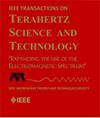利用硅微机械分频天线研究亚太赫兹计算成像
IF 3.9
2区 工程技术
Q2 ENGINEERING, ELECTRICAL & ELECTRONIC
IEEE Transactions on Terahertz Science and Technology
Pub Date : 2025-06-02
DOI:10.1109/TTHZ.2025.3575636
引用次数: 0
摘要
本文研究了亚太赫兹计算成像使用紧凑,宽带,腔背频变天线通过硅微加工技术制造。本文提出了一种基于伪随机频率变化模式的前向模型,该模型使用Mills-Cross发射器和接收器对,在220-330 GHz频率范围内提供高分辨率成像能力。该模型结合了先进的压缩感知算法,特别是压缩采样匹配追踪(CoSaMP)和快速迭代收缩阈值算法(FISTA),以提高有限数据采集下的成像性能。通过仿真和实验数据,证明了该系统在存在噪声的情况下也能实现低至1.4 mm的距离分辨率和0.35°的角度分辨率,并分析了计算复杂度和成像精度之间的权衡。本文对空间天线群和频率样本的稀疏性研究进行了全面的探讨。结果表明,仅使用6.7%的数据,CoSaMP算法就能重建出可识别的“KTH”标志图像。结果表明,CoSaMP对稀疏目标分布具有较低的重建误差,而FISTA具有较好的噪声恢复能力。该研究强调了在需要亚太赫兹频率高分辨率成像的安全筛查和工业检查中使用频率变化天线的实际意义。本文章由计算机程序翻译,如有差异,请以英文原文为准。
Investigating Sub-THz Computational Imaging Using Silicon Micromachined Frequency-Diverse Antennas
This article investigates sub-THz computational imaging using compact, wideband, cavity-backed frequency-diverse antennas fabricated through silicon micromachining techniques. This article presents a forward model based on pseudorandom frequency-diverse patterns using a Mills-Cross transmitter and receiver pair, which provides high-resolution imaging capabilities in the 220–330 GHz frequency range. The model is coupled with advanced compressed sensing algorithms, specifically compressive sampling matching pursuit (CoSaMP) and fast iterative shrinkage-thresholding algorithm (FISTA), to enhance imaging performance under limited data acquisition. Through emulated simulation and experimental data, it is demonstrated that the system's ability to achieve range resolutions down to 1.4 mm and angular resolutions of 0.35°, even in the presence of noise, and analyze the tradeoff between computational complexity and imaging accuracy. Sparsity investigations in spatial antenna population and frequency samples are comprehensively explored in this article. The results show that using only 6.7% of the data, the CoSaMP algorithm can reconstruct a discernable image of the “KTH” logo. Results show that CoSaMP provides lower reconstruction error for sparse target distributions, while FISTA achieves superior noise resilience. The study highlights the practical implications of using frequency-diverse antennas in security screening and industrial inspection, where high-resolution imaging at sub-THz frequencies is demanded.
求助全文
通过发布文献求助,成功后即可免费获取论文全文。
去求助
来源期刊

IEEE Transactions on Terahertz Science and Technology
ENGINEERING, ELECTRICAL & ELECTRONIC-OPTICS
CiteScore
7.10
自引率
9.40%
发文量
102
期刊介绍:
IEEE Transactions on Terahertz Science and Technology focuses on original research on Terahertz theory, techniques, and applications as they relate to components, devices, circuits, and systems involving the generation, transmission, and detection of Terahertz waves.
 求助内容:
求助内容: 应助结果提醒方式:
应助结果提醒方式:


